Italy
Experience Italy's La Dolce Vita (the sweet life)
Italy, a vibrant country nestled in the heart of the Mediterranean, beckons travelers with its breathtaking beauty, rich history, and endless possibilities for exploration. From the enchanting Amalfi Coast to the picturesque hilltowns of Tuscany, Italy offers an array of unforgettable experiences. Marvel at the ancient ruins of the Roman Forum and wander through the storied paths of Nero's beautiful garden atop Palatine Hill. Delve into the vast treasures housed within the renowned Vatican Museum in Rome.
Indulge in the ethereal landscapes of Tuscany, sipping regional wines as the sun sets over vineyards and hilltop towns. Lose yourself amidst the colorful villas that cling to the cliffs of the Cinque Terre or revel in the splendor of coastal vistas along the Amalfi Coast. And, of course, a gondola ride in Venice promises a memory that will endure. Italy offers an astonishing and unforgettable journey through time that will leave you breathless.
Rome
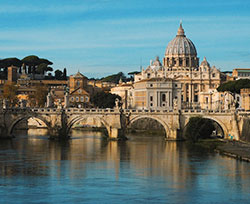
Photo by Gizem Ş. / Pexels |
The Eternal City enthralls visitors with its iconic landmarks, including the awe-inspiring Colosseum, where the grandeur of ancient Rome comes alive. Stroll through the cobbled streets of the historic center, explore the fascinating ruins of the Roman Forum, and wander through Vatican City, home to St. Peter's Basilica and the renowned Sistine Chapel, adorned with Michelangelo's masterpieces. |
|
Florence
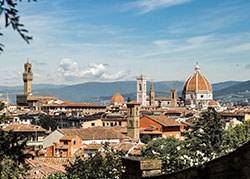
Photo by
Vladimir Gladkov / Pexels | Immerse yourself in the Renaissance charm of Florence, a city bursting with artistic and architectural wonders. Marvel at Michelangelo's David at the Accademia Gallery, stroll across the stunning Ponte Vecchio bridge, and visit the Uffizi Gallery to admire masterpieces by Botticelli, Leonardo da Vinci, and Raphael. Don't miss the imposing Florence Cathedral, crowned by Brunelleschi's magnificent dome. |
Venice
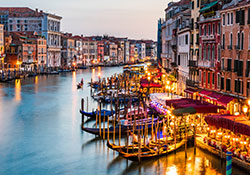
Nicola Simeoni / Adobe Stock | Explore the enchanting canals of Venice aboard a gondola as the sun goes down. Lose yourself in the narrow streets of this unique city, visit St. Mark's Square, and marvel at the ornate Byzantine architecture of St. Mark's Basilica. Enjoy a fresh pasta dinner and sip wine at one of the restaurants by the Rialto Bridge. xplore the Peggy Guggenheim Museum modern art collection, and take a water taxi over to Murano and see wonderful artisan's glass art work and tour a glass factory. |
|
Tuscany
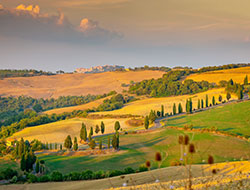
Photo by Vyha / Adobe Stock | The scenic region of Tuscany is famous for its rolling hills, vineyards, and charming medieval towns like Siena, a UNESCO World Heritage Site. Or visit the charming hilltop town of San Gimignano. Another popular hilltown is Montepulciano, which is amous for its Vino Nobile wine, Renaissance palaces, ancient churches, and underground wine cellars. | |
Another lovely town to consider visiting is Arezzo, which offers beautiful piazzas, medieval architecture, and connection to the arts. Or visit Volterra, located atop a rocky hill, and see the Etruscan ruins. Explore the ancient Etruscan walls, visit the Etruscan Museum, and discover the town's alabaster craftsmanship. |
Amalfi Coast:
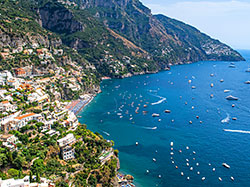
Photo by Emran Yousof / Unsplash | The Amalfi Coast captivates with its dramatic cliffs, azure waters, and picturesque towns clinging to the mountainside. Wander through the pastel-colored streets of Positano, situated on a stunning cliffside location with picturesque views of the Tyrrhenian Sea, (part of the Mediterranean Sea). Relax on beautiful beaches, and savor local delicacies at waterfront restaurants. Visit the historic town of Amalfi, with its stunning cathedral, and embark on a scenic boat tour to explore the enchanting island of Capri. | |
Book a scenic driving tour of the spectacular Amalfi coast, and enjoy many scenic viewpoints with photo opportunities along the way. Note that this is a very narrow winding road, and is best navigated by an experienced driver who knows the road very well. |
Lake Como
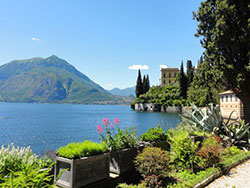
Photo by Charmaine Anderson | Nestled amidst the picturesque Italian Alps, Lake Como exudes elegance and tranquility. You can take a ferry to visit charming lakeside towns with colorful villas, shops and restaurants. Two popular towns there include beautiful Bellagio, known for its beautiful villas, lush gardens, and narrow, cobblestone streets. Visitors can explore Villa Melzi's gardens, enjoy lakeside dining, and take in panoramic views from the town's promenade. | |
Varenna is another lovely town on Lake Como, located on the eastern shore of the lake.
It boasts a romantic atmosphere with colorful villas, winding alleys, restaurants and a lakeside promenade.
Varenna is home to the beautiful Villa Monastero which has a lovely lakeside garden pictured here. Varenna offers ferry connections to other towns on the lake. |
Naples

Photo by Ava Peattie / Adobe Stock | Experience the vibrant energy of Naples, a city teeming with life and a treasure trove of art, history, and culinary delights. Explore the UNESCO-listed historic center, with its narrow streets and bustling piazzas. Looming in the distance is Mount Vesuvius, the volcano responsible for the catastrophic eruption in 79 AD that destroyed the ancient Roman cities of Pompeii and Herculaneum, along with several other nearby settlements. | | For an unforgettable experience, take a short train ride to Pompeii and wander through the fascinating ruins. Visit the National Archaeological Museum and see the artifacts from Pompeii and Herculaneum. |
Cinque Terre

Photo by Charmaine Anderson | Discover the charm of Cinque Terre, a collection of five colorful fishing villages nestled along the rugged Ligurian coastline. Hike the scenic trails that connect the villages, offering breathtaking views of the Mediterranean Sea. Explore the charming streets and have lunch on the charming waterfront of Vernazza, sample fresh seafood in Monterosso, and capture postcard-perfect moments in the quaint village of Manarola. |
Best Time to Visit:
The best time to visit Italy depends on your preferences and the specific regions you plan to explore. Italy experiences a diverse climate. It's important to note that weather patterns can vary across Italy, so it's a good idea to check specific regional climates when planning your trip. Also, consider any festivals or events you may want to attend, as they can add a unique flavor to your visit. Here are some considerations for each season:
Spring (April to June): Spring is generally a pleasant time to visit, with mild temperatures, blooming flowers, and fewer crowds. It's an excellent time to explore cities, cultural sites, and enjoy outdoor activities. However, popular destinations like Florence and Rome can still be busy, particularly during Easter.
Summer (July to August): Summer is peak tourist season in Italy, especially in coastal areas and popular cities. The weather is generally hot and sunny, making it ideal for beach vacations and outdoor sightseeing. However, expect larger crowds and higher prices. Consider visiting lesser-known regions or planning your visits to major attractions during less busy times of the day.
Autumn (September to October): Autumn brings cooler temperatures, especially in October, making it a pleasant time to visit Italy. The countryside transforms into beautiful fall colors, and wine regions like Tuscany and Piedmont are bustling with harvest activities. It's a good time for cultural exploration and enjoying local festivals.
Winter (November to February): Winter is the low season in most of Italy, except for popular skiing destinations like the Dolomites. While cities are less crowded, some attractions and restaurants may have limited hours. However, winter can be a great time to visit if you want to experience Italian culture, Christmas markets, and enjoy winter sports in the mountains.
Travel Planning Tips:
Plan Ahead: Determine how long you plan to stay in Italy and allocate your time accordingly. Italy can get crowded during peak tourist seasons. Consider booking train tickets and popular attractions in advance to avoid long queues and ensure availability.
Cash and Currency: The official currency of Italy is the Euro (€). It is the widely accepted form of payment throughout the country. It's recommended to have some Euros with you when traveling to Italy for convenience, as many places may not accept other currencies or credit cards in smaller establishments. You can exchange currency at banks, exchange offices, or ATMs, which are widely available in most cities and towns.
Travel Insurance: Ensure that you have comprehensive travel insurance that covers medical expenses, trip cancellation, and any potential emergencies. Review the policy details and know how to access medical assistance if needed.
Vaccinations: It's highly advisable to check with your doctor if any vaccinations are recommended before traveling to Italy. It's worth noting that vaccination requirements and recommendations may change over time, so it's always a good idea to stay updated on the latest information from reputable sources such as the Centers for Disease Control and Prevention (CDC) or the World Health Organization (WHO) before traveling to Italy.
Language: While the official language of Italy is Italian, English is generally understood and spoken to some extent in popular tourist areas, larger cities, and among younger generations. In major cities like Rome, Florence, Milan, and Venice, you are more likely to encounter English speakers, especially in tourist-oriented establishments such as hotels, restaurants, and attractions.
However, it's important to note that English proficiency levels can vary among individuals. In rural areas or smaller towns, you may encounter fewer English speakers, and communication in Italian or basic phrases can be helpful. It's always a good idea to learn a few common Italian phrases and carry a phrasebook or translation app to assist with communication. Here are some common phrases:
- Good morning: "Buongiorno" (bwohn-jor-noh)
- Good evening: "Buonasera" (bwoh-nah-seh-rah)
- Please: "Per favore" (pehr fah-voh-reh)
- Thank you: "Grazie" (grahts-ee-eh)
Local Customs and Etiquette: Dress modestly when visiting churches or religious sites, and be mindful of appropriate behavior in sacred places.
Drink responsibly: Italy is known for its excellent wines and spirits, but it's essential to consume alcohol responsibly. Excessive drinking can impair judgment and make you vulnerable to accidents or theft.
Travel Documents: Ensure that your passport is valid for at least six months beyond your planned departure date. Check the expiration date before your trip and renew it if necessary.
Visa (if applicable): Depending on your nationality, you may need a visa to enter Italy. Citizens of many countries, including the United States, Canada, Australia, and most European Union countries, can enter Italy for tourist purposes without a visa for stays of up to 90 days. However, it's important to check the visa requirements based on your citizenship before traveling.
Accommodations:
- Hotels: Italy has a plethora of hotels, ranging from budget-friendly options to luxurious establishments. You can find internationally recognized hotel chains as well as charming boutique hotels. It's advisable to book in advance, especially during peak tourist seasons.
- Bed and Breakfast: B&Bs are popular in Italy, particularly in smaller towns and rural areas. They often offer a more intimate and personalized experience, with comfortable rooms and a hearty breakfast included.
- Agriturismo: In rural areas, you can find agriturismos, which are farm stays that provide accommodation and often showcase local agricultural activities. It's an excellent way to experience the countryside and sample traditional Italian cuisine.
- Vacation Rentals: Renting apartments, villas, or vacation homes is a popular choice, especially for longer stays or for travelers who prefer more space and privacy. Websites like Airbnb and HomeAway offer a variety of options throughout Italy.
- Guesthouses and Pensioni: Guesthouses and pensioni are smaller establishments that offer a more intimate and homely atmosphere. They are often family-run and provide a cozy and affordable accommodation option.
Transportation:
Research your desired destinations and their transportation options in advance. Check timetables, ticket prices, and any potential changes or disruptions to ensure smooth travel experiences.
- Domestic Flights: Domestic flights provide a quick and efficient way to cover long distances within Italy. Several airlines operate domestic routes, connecting major cities and popular tourist destinations. When considering domestic flights, compare prices and schedules from different airlines to find the most convenient option. Remember to arrive at the airport in advance, as security procedures and boarding processes may take some time. Pack light or check the baggage allowance and restrictions to avoid any additional fees. Keep in mind that traveling by plane may require additional time for airport transfers and check-in procedures compared to other modes of transportation.
- Public Transportation: Italy has an extensive and efficient public transportation system, including trains, buses, and trams. Opt for trains when traveling between cities, as they are often faster and more convenient than driving or flying.
- Trains Trains are a popular and mostly reliable mode of transportation in Italy, offering an extensive network that connects major cities and picturesque regions. While delays can occasionally occur, improvements have been made to enhance punctuality and efficiency. Italy's high-speed trains, such as the Frecciarossa and Frecciargento, provide fast and comfortable travel options. Stay alert at train stations. Train stations, particularly in larger cities, can attract opportunistic thieves. Keep an eye on your belongings, especially when boarding or disembarking trains, and avoid leaving bags unattended.
- Validate your train tickets: When traveling by train, ensure you validate your ticket using the machines at the platform before boarding. Failure to do so may result in a fine if caught by the conductor during the journey.
- Buses: Buses in Italy provide an affordable and convenient way to navigate within cities and travel between towns. Research schedules and routes in advance, purchase tickets ahead of time, and remember to validate them onboard. Be prepared for crowded buses during peak hours and have small change for ticket purchases. Stay informed about potential bus strikes and consider alternative transportation options if needed. Seek assistance from bus stations or tourist offices for any inquiries.
- Taxis: Taxis are readily available in Italian cities and can be a convenient mode of transportation, especially for short distances or when carrying heavy luggage. Look for licensed taxis with official signage and meters. It's advisable to ask for an estimated fare before starting the journey. Be aware that taxi fares may be higher during late-night hours or in touristy areas. Keep small denominations of cash for payment, as some taxis may not accept credit cards. Tipping is not obligatory but appreciated for excellent service. Exercise caution when using unlicensed or unofficial taxis.
- Renting a Car: If you plan to explore the countryside or smaller towns, renting a car can provide more flexibility. However, be aware that driving in larger cities like Rome or Florence can be challenging due to traffic and limited parking.
- Walking: Many Italian cities are best explored on foot, as they are compact and filled with narrow streets and charming alleyways. Take comfortable shoes and enjoy leisurely strolls to discover hidden gems.
Safety Tips:
- Beware of pickpockets: Like any tourist destination, Italy has its share of pickpockets. Be vigilant in crowded areas, such as when boarding a train, keep your belongings secure, don't let strangers help you with your luggage, and consider using a money belt or a cross-body bag to deter theft.
- Be cautious of scams: Be wary of individuals offering unsolicited help or trying to distract you. Common scams include "friendship" bracelets, petitions, and unwanted assistance with luggage. Politely decline and continue on your way.
- Stay hydrated and use sunscreen: Italy's Mediterranean climate can be hot, especially during the summer months. Stay hydrated by carrying a water bottle and apply sunscreen to protect your skin from the sun's rays.
- Drink bottled or treated water: While tap water in most cities in Italy is safe for drinking, it's often preferred to drink bottled water, especially in rural areas or smaller towns. If tap water is consumed, ensure it is properly treated or filtered.
- Vaccinations: Check with your healthcare provider or travel clinic well in advance about recommended vaccinations before visiting Italy, such as ensuring you have the latest COVID-19 vaccine before traveling abroad.
- Prescription Medications:If you take prescription medications, ensure you have an ample supply for the duration of your trip. Carry them in their original packaging, along with copies of prescriptions, in case you need to refill or replace them during your trip.
- Food Safety: Choose restaurants and food vendors that are busy and popular with locals, as they tend to have high turnover and fresher ingredients.While street food can be tempting, exercise caution and consider the cleanliness and proper food handling practices of the vendor. Opt for cooked foods that are served hot and prepared right in front of you.
- Bathroom Tissue In high traffic or remote areas, bathrooms may not be serviced frequently, so its a good idea to carry a pack of tissues or wipes just in case they run out.
- Emergency Services: Dial 112 (This number can be dialed for all emergencies, including police, medical, and fire services.) Police is: 112 or 113. Medical Emergency is 118, Fire Department is 115, and Roadside Assistance is 803116. Coast Guard is 1530 (for maritime emergencies). Be prepared to provide your location and a clear description of the emergency when making an emergency call.
- Travel Advisories Stay updated on current events, local regulations, and any travel advisories when traveling abroad. Visit the US Government State Department Travel Advisories web site to check on the status of your destination.
- Enroll in the STEP Program: Travelers are also urged to enroll in the U.S. State Department's Smart Traveler Enrollment Program (STEP) to receive security messages and to make it easier to locate them in an emergency. The Department uses these security messages to convey information about terrorist threats, security incidents, planned demonstrations, natural disasters, etc. In an emergency, please contact the nearest U.S. Embassy or consulate or call the following numbers: 1 (888) 407-4747 (toll-free in the United States and Canada) or 1 (202) 501-4444 from other countries.
| |
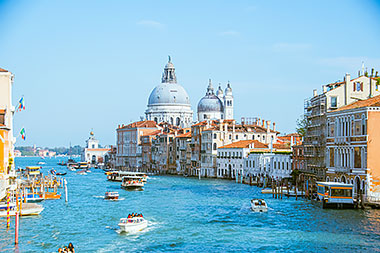 Photo by Siegfried Poepperl
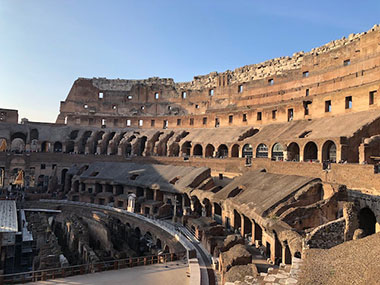 Collesium interior
Photo Stellpix
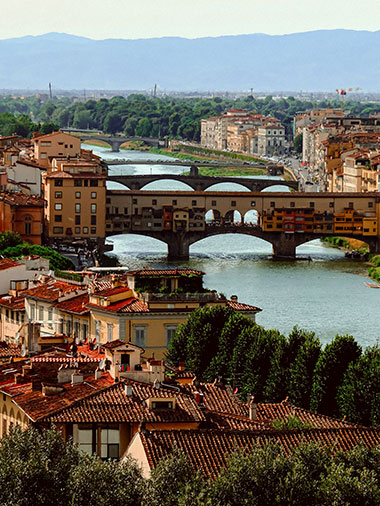
Bridges over Arno River, Florence Photo by Mmonica Oprea
|
 Photo by Siegfried Poepperl
Photo by Siegfried Poepperl  Collesium interior
Collesium interior  Bridges over Arno River, Florence
Bridges over Arno River, Florence